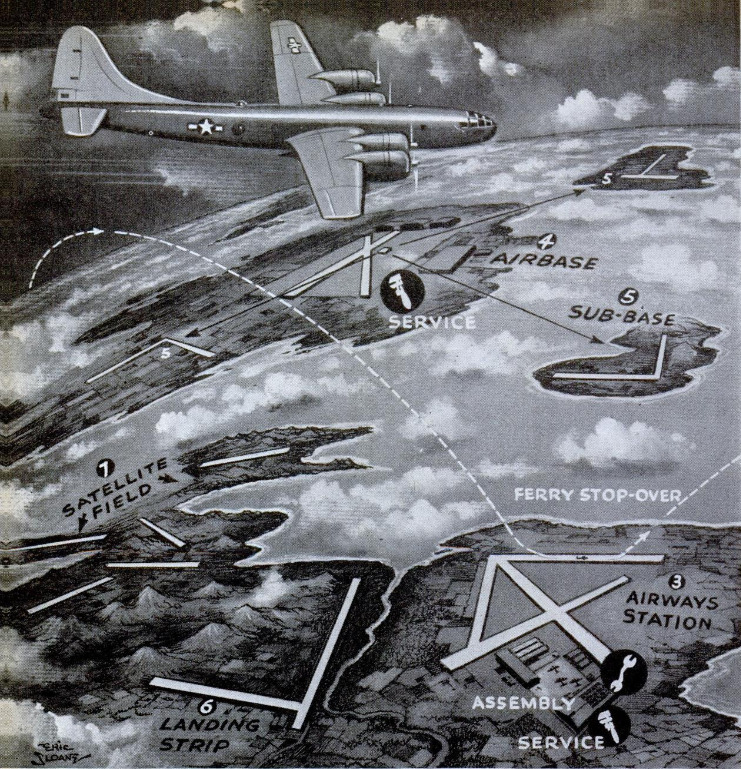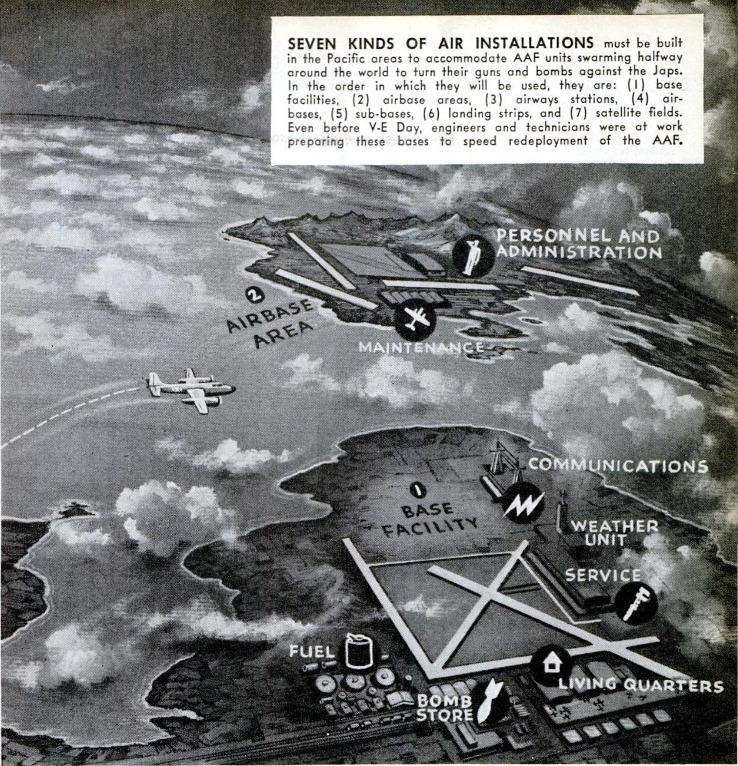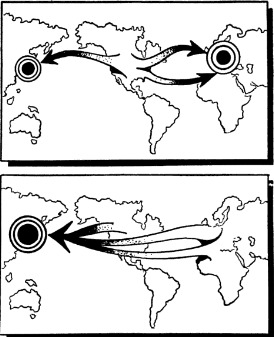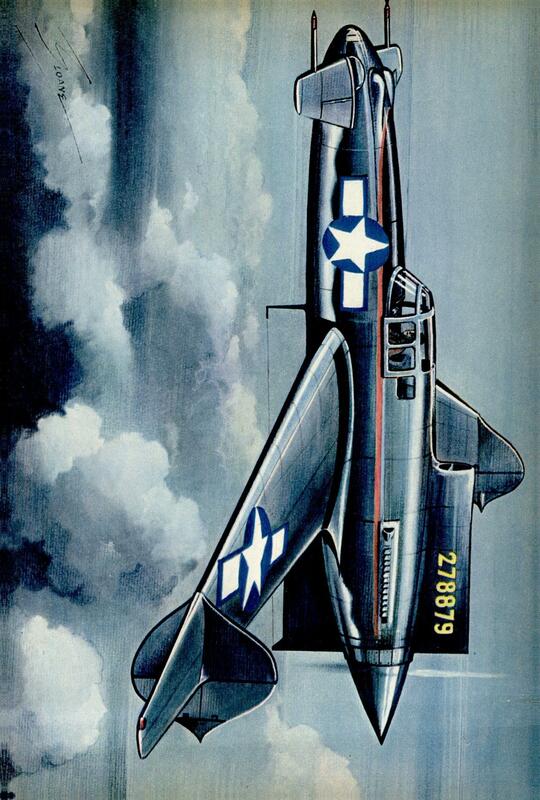-
Title (Dublin Core)
-
When the AAF throws
-
Article Title and/or Image Caption (Dublin Core)
-
When the AAF throws
-
extracted text (Extract Text)
-
FOR the big job of moving our airpower
from Europe to the Pacific, an AAF engi- |
neering officer said, “We've got to have the
land. Then the bases have to be laid out and
carved out. On these airdromes and back
of them, we have to set up depots of various
sizes. Next comes the equipment for the
service units, and the stockpiles of matériel
and housekeeping items. Fuel comes in.
‘Then, and only then, are we ready to bring
in the planes.”
It is a transplanting operation of global
proportions that involves every type of con-
veyance that moves on land, on sea, and in
the air. And in carrying out this “bulk re-
deployment” of the AAF we had to start
from scratch. We have not the land, the
facilities, or the supplies on the scene, such
as were available in England under reverse
lend-lease; and, with the exception of China,
there is no ally in the Pacific from which we
can draw on local civilian help. Every sin-
gle pick and shovel, screwdriver, gasoline
drum, and box of rations must be sent from
either Europe or the U. S. Either way, it is
nearly halfway around the world.
The planning for this tremendous task
began in Washington
almost a year before
the Germans surren-
dered. Commencing in |
the offices of the Joint
Chiefs of Staff, the |
Army-Navy Logistics
Board, and Gen. “Hap” |
Arnold of the AAF,
these plans coursed
through channels all
the way down to Joe
Doaks and Mary
Smith, who sort rivets
in some two-by-four |
plant of a subcontrac- |
tor in the alley back
of Main Street. |
The elaborate plan
calls for the moving |
of everything but the |
bases. Even the Army |
and Navy cannot bulk- |
redeploy airdromes, |
and these must be pre- |
pared and equipped
in order that the re-
deployed AAF will have somewhere to go
when it arrives in the Pacific.
That is why the redeployment of aviation
engineers, technicians, and some air units
was under way when V-E Day arrived. The
tactical demands of the Pacific areas make
it necessary for these engineers—who will
be aided by Navy Seabees—to lay out, build,
and equip seven different kinds of air in-
stallations. These are described in the order
in which they will be used to make possible
the redeployment:
Largest are “base facilities” that include
service units, four-echelon depots, under-
ground storage for fuel and bombs and other
ammunition, weather and communications
units, and living quarters. They will take
on the aspect of regular staging areas.
“Airbase areas” will include a number of
landing strips or dispersal areas, and on
these will be located personnel and facilities
for administration, maintenance, supply, and
salvage.
“Airways stations” will be large air-
dromes with complete servicing facilities,
which will be used, primarily, as stopover
points for ferried planes. Some of these may
be used for the assembly of processed planes
that have been shipped.
“Airbases” are somewhat smaller and are
equipped with sub-depot or service squad-
ron shops. The commanding officers of these
may also have under
their control alternate
‘‘sub-bases.”
“Landing strips” are
located in forward
areas for purely tac-
tical operations. Sev-
eral of these, widely
dispersed, constitute a
“satellite field.”
The redeployed en-
gineers who are build-
ing these, or enlarg-
ing existing facilities,
all over the Pacific
area carried with them
only the most essen-
tial equipment. Every-
thing that they re-
quired was sent direct
from the U. S. and
cleverly scheduled and
routed so as to reach
the respective points
at the same time as
the men from the ETO
and Mediterranean.
This “marrying” of men and matériel is the
most intricate single phase of our redeploy-
ment scheme.
For example, the flow of matériel to Eu-
rope was so strong that we began last Oc-
tober to close the valve of this pipe line. In
anticipation of the surrender of the Nazis
and the possibility of having to reroute the
shipments of aircraft and other weapons to
the Pacific, a coding scheme was employed
to govern ship movements and loadings.
Some vessels were marked “STO,” meaning
that they were to be stopped enroute in the
event of the war's end in Europe. Others
were labeled “SHP” to indicate that they
would carry cargo that would be needed in
any event. But many of these carried planes
and parts. The other cargo was unloaded,
but the planes were shipped back- to the
U. S. or routed through the Mediterranean
to the Pacific. (When V-E Day arrived, 89
ships were halted at sea or recalled from
foreign ports without discharging cargo.)
If it seems incongruous that swiftly mov-
ing airpower must be anchored to the slow-
moving convoys, this is so because of the
great variety of things needed to keep an
air unit in operation. Some of these items
cannot be transported by air in sufficient
quantities.
President Truman revealed recently that
20 bombardment
groups had received orders to move from
Europe to the Far East. This number of
Flying Fortress and Liberator groups adds
up to 960 bombers, plus spares. These will
be flown to the Pacific areas, carrying with
them combat crews and some 650 tons of
immediately needed equipment. The air
echelon required to keep 'em flying after
these bombers arrive includes 4,440 spe-
clalists and technicians, and the task of re-
deploying these men demands the use of 960
Skytrain or Commando transport planes—
a fleet of planes that would take about four
hours to pass over any given point.
But this is the easiest part of the rede-
ployment. The relatively simple expedient of
transporting the planes, men and matériel
by air presents none of the difficulties fac-
ing those who must prepare for the move-
ment of the remaining personnel and equip-
ment of the 20 bomber outfits. On the
ground are left some 22,000 men and 15,800
tons of miscellaneous ground equipment that
includes everything trom bulldozers and 2%-
ton trucks to hardware such as socket
wrenches and nuts and bolts.
Railroad transportation of this comple-
ment to the nearest port will require 2,140
flat cars, 520 boxcars, 484 coaches, and 200
Kitchen and baggage cars. To embark these
men and matériel, 10 Liberty ships and nine
Army transports will be needed. Not taken
into account is the stockpile of food and
other essentials these men will consume dur-
ing the 14,000-mile voyage to some Pacific
point such as Manila.
The moving of fighter outfits will be a
slower and more complex operation. It is
not practical to ferry even the long-range
Mustangs, Thunderbolts, Lightnings, and
Black Widows over such distances. These
fighters will be shipped, along with their
combat crews, service personnel, and essen-
tial equipment.
Comparatively few fighters will be sent
from Europe to the Pacific. Only the latest
modifications, and those in the best condi-
tion, are to be redeployed. Others will be
returned to the U. S. for limited use; still
others are being scrapped for salvage. One
officer of the Air Technical Service Com-
mand, whose job it is to supply the combat
units, said, “Tt would save a lot of time,
trouble, and expense to burn on the spot
every small airplane that we won't use
against the Japs!”
Fighters that will be used are being fer-
ried from their unit bases to ATSC “proc-
essing centers” which are modeled along the
lines of the Port Newark and Oakland Over-
seas Command bases, through which passes
the flow of new aircraft to the Pacific com-
bat theaters. These centers in Europe will
be as painstaking in their work as the huge
installations here at home; there can be no
short cuts in this phase of redeployment.
We cannot afford to ship a fighter from 10,-
000 to 14,000 miles and have it arrive unfit
for immediate use.
If we consider the redeployment of, say,
ten fighter groups, each comprising some
75 planes and 1,000 men, plus spares and
equipment, it adds up to a fair-sized convoy
in itself. Thirty-three Liberties and tankers
will be required to hold the planes and some
packed parts; five Victory ships and five
transports will be needed to move the men
and the heavier equipment. More than twice
the shipping used to move 20 heavy-bomber
groups is necessary to move only ten fighter
groups and their planes.
The men from the European theater who
will fly these planes are being given short
indoctrination courses to acquaint them with
the new planes and the operating conditions
they will encounter in the Pacific. For the
most part, these differences involve more
over-water flying, more low-altitude flying
in all operations including strategic bomb-
ing, and the increased use of rockets. Pilots
who flew Marauder medium bombers in
Europe are undergoing a three-months tran-
sitional course in A-26 Invaders; so are some
of the men who flew Mitchells. Only the
latest B-25 modifications are being sent to
the Far East, and these carry rockets.
“If those Nips,” declared a procurement
officer sagely, “had any idea today how big
this thing really is and what we're getting
ready to throw at them tomorrow, they'd
have surrendered yesterday!”
-
Contributor (Dublin Core)
-
James L. H. Peck (article writer)
-
Language (Dublin Core)
-
eng
-
Date Issued (Dublin Core)
-
1945-08
-
pages (Bibliographic Ontology)
-
78-81,194,198
-
Rights (Dublin Core)
-
Public domain
-
Archived by (Dublin Core)
-
Sami Akbiyik
-
Marco Bortolami (editor)
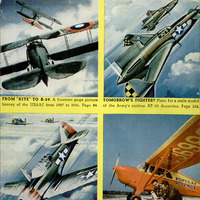 Popular Science Monthly, v. 147, n. 2, 1945
Popular Science Monthly, v. 147, n. 2, 1945

